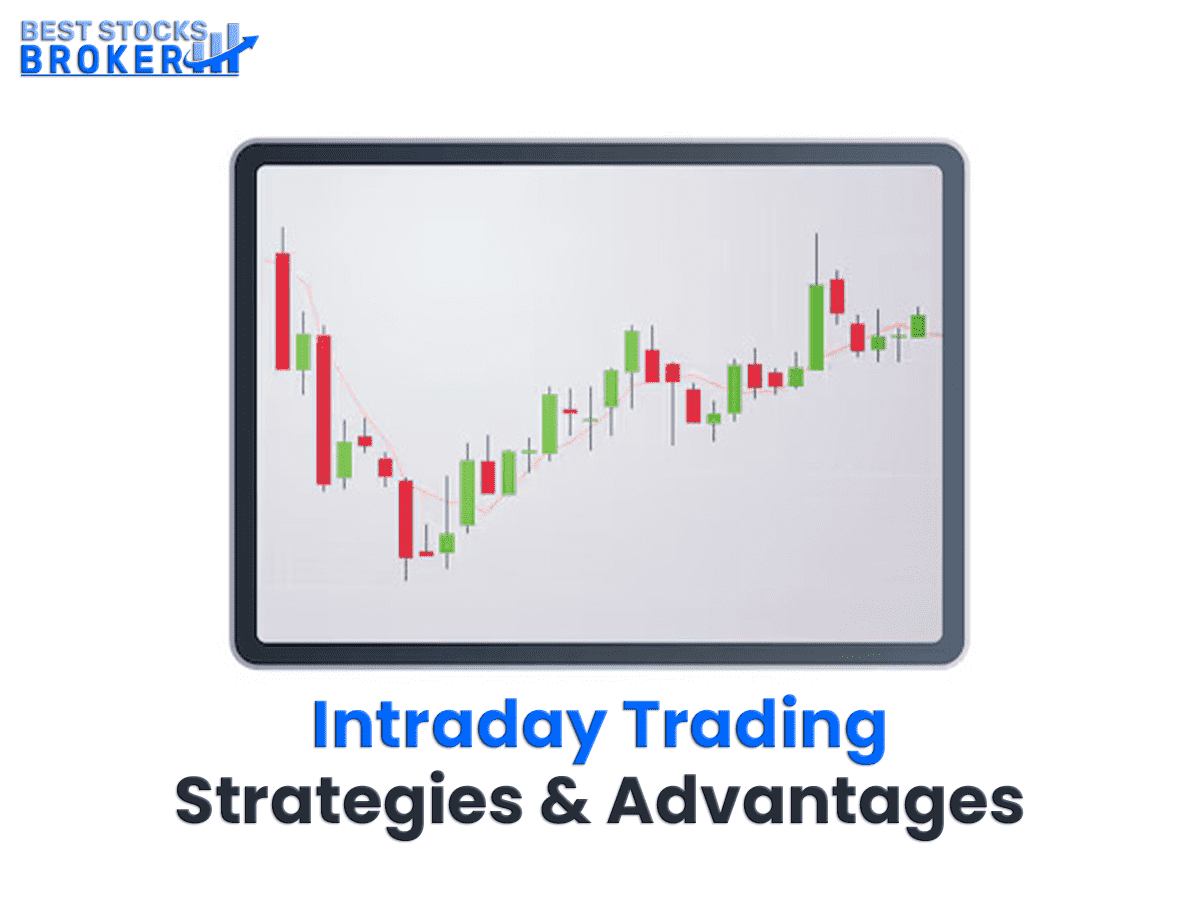What is Intraday Trading?
Intraday trading is day trading. In intraday trading, the shares are purchased and sold on the same day. You can not hold the intraday stocks overnight. Intraday trading aims at short-term price movements to make intraday profit. Intraday trading takes advantage of price volatility that occurs during the daytime. Intraday traders make quick buy and sell decisions, including multiple trades in a day.

Table of Contents
Best Intraday Trading Strategies
1. Moving Average Crossover Strategy:
A moving average crossover is a crossover that occurs when two moving average lines intersect each other. This technical tool can assist you in determining the optimal time to buy and sell. Moving averages are a lagging indicator, so they may not reflect the exact peaks and troughs of the market. However, they can help you recognize the main direction of the movement. When the moving averages cross each other, it may indicate that the market is shifting soon, allowing you to enter at a better price.
A crossover system has some limitations, though. It works well in a volatile and/or trending market, but not so much in a sideways market. The crossover system provides specific signals for when to enter and exit the market. To sum up, moving average crossovers are useful for identifying the beginning or the end of a trend.
2. Reversal Trading Strategy:
Reversal trading, also called pull-back trading, is a strategy that involves trading against the price trends of stocks, expecting them to make a “Reversal”. In a reversal intraday trading strategy, traders look for stocks that are at extreme highs and lows. These stocks have a high probability of changing direction. When the security’s movement reverses, a stop is set and the traders wait for the securities to reach maximum volatility. A trade is made when the reversal value reaches the trader’s target limit.
In trading, a reversal means a shift in the direction of an asset’s price. The trend reversal trading strategy is used by both day traders and long-term investors to decide when to buy or sell a market. Traders trade reversals by examining price actions using trend lines and trading channels. They use technical indicators, such as moving average (MA) and moving average convergence divergence (MACD) to help them identify and locate reversals.
3. Momentum Trading Strategy:
Momentum trading is a strategy that relies on the power of price movements to open positions. Successful intraday trading strategies are focused on finding moving stocks that fluctuate daily. You can find about 25-35% of stocks that fluctuate. This fluctuation is known as momentum. Stock scanners are used to find these stocks. It is based on the concept that if a price move has enough momentum, it will keep moving in the same direction. When an asset reaches a higher price, it usually draws more interest from traders and investors, which drives the market price even higher. This continues until a large number of sellers join the market – for instance when an unexpected event makes them reconsider the asset’s price. Once there are enough sellers in the market, the momentum shifts direction and will push an asset’s price lower. These stocks tend to move above the moving average without any obstacle in high volume.
A catalyst like earnings can trigger momentum in the stocks but it can also be created without any fundamental support. This is called a technical breakout. In momentum trading strategy the traders try to select those stocks that move in one direction in high volume. The profit-to-loss ratio in the momentum trading strategy is 2:1. A trader can hold the stocks for minutes, days, or hours depending on the speed of movement of the stocks.
4. Gap and Go Trading strategy:
A gap-up occurs when the stock price opens higher than the previous day’s closing price. Conversely, a gap down happens when the stock price opens lower than the previous day’s closing price. This intraday trading strategy targets gapers. Gapers are those points on the stock chart where there is no trading activity. These points are called gapers. These gaps can be caused by factors such as news spikes, earnings reports, or a trader’s trading strategy change.
The gap-and-go strategy is when a stock gaps up from the previous day’s closing price. If you want to do gap trading successfully, the most common strategy is to use a pre-market scanner and look for stocks that have volume in the premarket. This strategy is considered the golden strategy for intraday trading among day traders. Every morning many gapping stocks show up on the pre-market scanners.
5. Bull Flag Trading Strategy:
The bull flag pattern is a continuation chart pattern that enables the uptrend to resume. The price action narrows within the two parallel trend lines in the opposite direction of the uptrend, before breaking out and advancing the uptrend. As the name implies, a bull flag is a bullish pattern, unlike a bear flag which occurs in the middle of a downtrend. A flagpole is formed when a strong price movement happens in a direction. When the resistance line is breached, it initiates a new movement and the stocks move forward. The bull flags are aggressive in the beginning. This is because it triggers a breakout and the bear is caught off guard.
The bull flag represents a strong price movement in a direction and then there is a pullback in such a way that there is a parallel high and low pattern. It takes a lot of time for the bull flag to form and for the upper and lower lines to emerge.
Advantages of Intraday Trading
1. You can make use of leverage:
Leverage in the stock market is similar to a bank loan. Intraday traders often use leverage to boost the amount of profit. The bank assesses your financial profile and approves the loan amount. Likewise, in the stock market, a broker assesses your shareholding record and cash availability status to approve a margin amount. You can get a margin of up to 10 times the available cash in your account. If you have 10000 rupees in your account you can buy shares of rupees 1 lakh.
2. Reduce overnight risks:
Stock prices move for various reasons, such as the company’s financial results, business prospects, industry status, and many macroeconomic factors. Furthermore, if any negative geopolitical or environmental news emerges after the market closes, the next day’s market might stay red. However, intraday traders seldom worry about such things, as they do everything in a day. Once the market closes, they can leave their worries behind and relax. No negative news can affect their peace of mind and money after the market closes.
3. Buy later sell first:
Usually, positional traders buy stocks first and sell them later. intraday trading allows you to sell stocks first and buy them later. Therefore, you can also trade and profit effectively in a bear market. Although futures and options also allow you to profit through short-selling, capital requirements are often higher than intraday trading. Therefore, if you want to use the ‘buy later sell first’ strategy to profit, intraday trading might be your best option.
Intraday Trading Tips
Follow these Share Market Intraday Tips to make expected returns:
- Follow your trading strategy and be consistent
- Choose stocks that are suitable for intraday trading
- Trade with funds that you can manage, and the loss doesn’t affect your financial situation
- Research carefully and select stocks that have high liquidity
- Monitor your financial profits and losses
Close all open positions of the day by 3:30 PM
Conclusion
Intraday trading for beginners may seem lucrative as it shows results in a shorter period, but you need to be cautious in this. Make a strategy that suits you and practice it well. Follow the above tips and always manage your emotions while day trading. As it is day trading and short-term trading, there are a lot of fluctuations of emotions such as fear, greed, etc. That’s why it becomes crucial to stay calm and trade carefully.
FAQs – 5 Best Intraday Trading Strategies
1. How many Intraday Trades I can take in a day?
Ans: There is no limit on how many trades you can take in a day. To make good profits it’s better to focus on only one or two trades.
2. Is Intraday Trading Good?
Ans: Yes, intraday trading is good for trading, but you need to practice your chosen strategy well and manage your emotions while trading.
3. Is it possible to earn 2000 Daily in Intraday Trading?
Ans: Yes, it is possible to earn 2000 in a day. You can even earn more but you need to manage risks well in your intraday trades and follow all the important tips with your strategy.
4. Which is better: Intraday Trading or Delivery?
Ans: It depends on your preferences and which type of trader you are. If you are a long-term trader who prefers to hold shares overnight then delivery trading is best for you. If you are a trader who does not want to carry positions overnight or take the risk of holding shares then intraday trading is best for you.
5. What is Intraday Trading Time?
Ans: Intraday trading time starts from 9:15 AM and ends at 3:30 PM.


